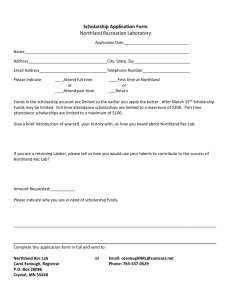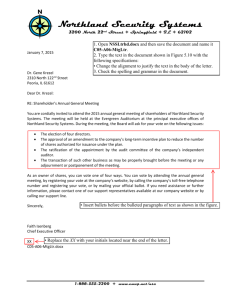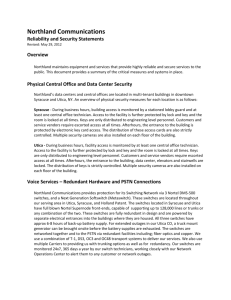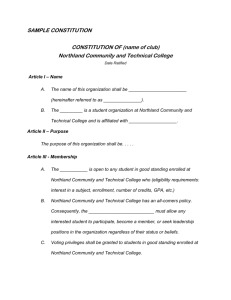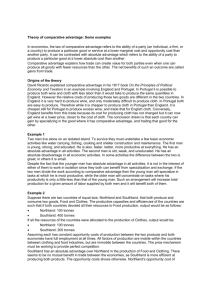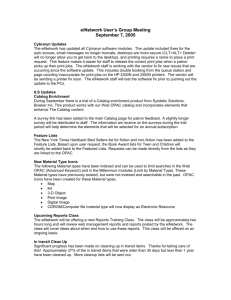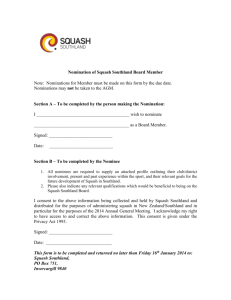10th Red Cross International Humanitarian Law Moot (2012) The
advertisement
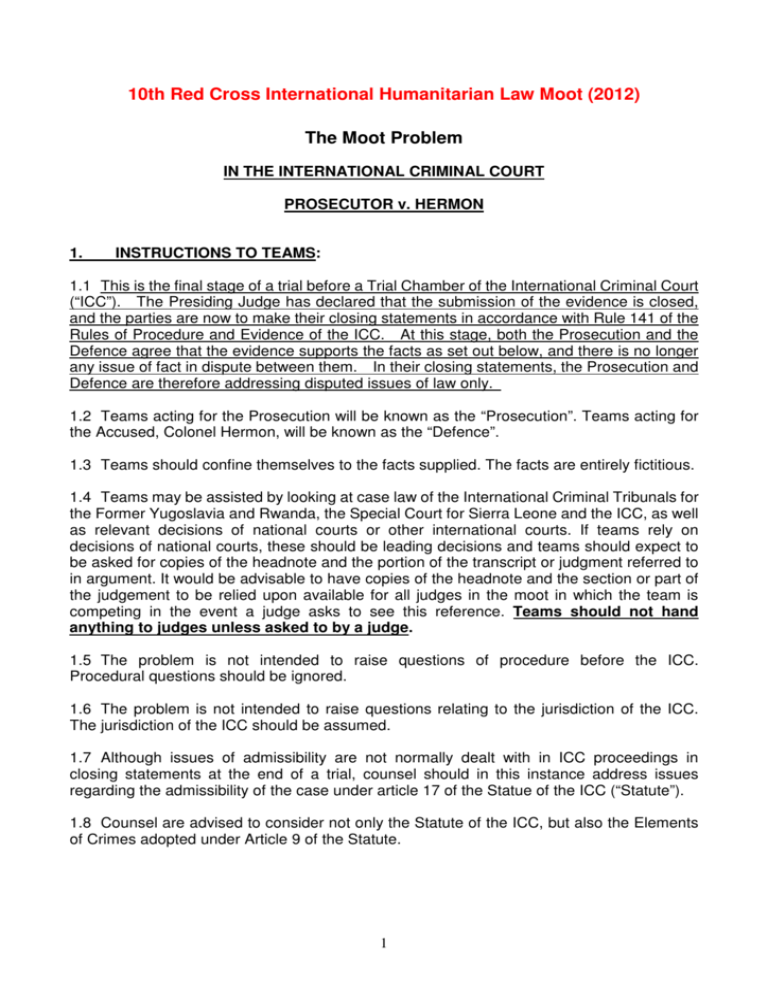
10th Red Cross International Humanitarian Law Moot (2012) The Moot Problem IN THE INTERNATIONAL CRIMINAL COURT PROSECUTOR v. HERMON 1. INSTRUCTIONS TO TEAMS: 1.1 This is the final stage of a trial before a Trial Chamber of the International Criminal Court (“ICC”). The Presiding Judge has declared that the submission of the evidence is closed, and the parties are now to make their closing statements in accordance with Rule 141 of the Rules of Procedure and Evidence of the ICC. At this stage, both the Prosecution and the Defence agree that the evidence supports the facts as set out below, and there is no longer any issue of fact in dispute between them. In their closing statements, the Prosecution and Defence are therefore addressing disputed issues of law only. 1.2 Teams acting for the Prosecution will be known as the “Prosecution”. Teams acting for the Accused, Colonel Hermon, will be known as the “Defence”. 1.3 Teams should confine themselves to the facts supplied. The facts are entirely fictitious. 1.4 Teams may be assisted by looking at case law of the International Criminal Tribunals for the Former Yugoslavia and Rwanda, the Special Court for Sierra Leone and the ICC, as well as relevant decisions of national courts or other international courts. If teams rely on decisions of national courts, these should be leading decisions and teams should expect to be asked for copies of the headnote and the portion of the transcript or judgment referred to in argument. It would be advisable to have copies of the headnote and the section or part of the judgement to be relied upon available for all judges in the moot in which the team is competing in the event a judge asks to see this reference. Teams should not hand anything to judges unless asked to by a judge. 1.5 The problem is not intended to raise questions of procedure before the ICC. Procedural questions should be ignored. 1.6 The problem is not intended to raise questions relating to the jurisdiction of the ICC. The jurisdiction of the ICC should be assumed. 1.7 Although issues of admissibility are not normally dealt with in ICC proceedings in closing statements at the end of a trial, counsel should in this instance address issues regarding the admissibility of the case under article 17 of the Statue of the ICC (“Statute”). 1.8 Counsel are advised to consider not only the Statute of the ICC, but also the Elements of Crimes adopted under Article 9 of the Statute. 1 2. THE FACTS 2.1 Northland and Southland are independent states that were formed out of a European colony some 80 years ago. They are both located on the western seaboard of a continent, Northland being the immediate northern neighbour of Southland. The River Trapp forms the border between the two states (the border being the middle of the river). Northland is a significantly wealthier country than Southland. Relations between the two countries have since independence been fragile, in large part because Northland still maintains certain historic claims to the northern part of Southland’s territory. 2.2 About 300 kilometres from the western seaboard of the continent is a mountain range known as the Dividing Mountains, which runs in a north/south direction. The eastern borders of both Northland and Southland run through the middle of this range. 2.3 The River Trapp begins in the far north-east of Northland, high in the Dividing Mountains, and flows for about 200 kilometres in a southerly direction through Northland, through or along the base of the Mountains, before turning to flow in a westerly direction for 300 kilometres until it reaches the sea. It is from the point where it turns west that it forms the border between Northland and Southland. 2.4 The capital of Northland is New Inn, located on the sea some 200 kilometres north of the river mouth. The capital of Southland is Ashfield, some 200 kilometres south of the river. 2.5 About 100 kilometres upstream from the river mouth, straddling both sides of the river, is the historical trading village of Princes Gate. Historically, both Northland and Southland have each claimed sovereignty over the part of Princes Gate that falls within their own territory. 2.6 There are three main ethnic groups in the region: Riverlanders. Northerners, Southerners and 2.7 Northerners are the largest group in Northland. They were the dominant group in colonial times in the entire region. Since independence, they have dominated political power, senior positions in the government, public service and military, and the business sector in Northland. Since colonial times they have enjoyed much better education, wealth and influence than other groups. Northerners live mainly in the north and northwest of Northland, including in the capital, New Inn. 2.8 Southerners are the largest group in Southland, and are the vast majority of the population in almost all parts of that country, except in the north, in the region running along the edge of the River Trapp. 2.9 Riverlanders are the second largest group in both Northland and Southland. They are the vast majority of the population in a strip of land, approximately 100 kilometres wide, running along both sides of the entire length of the River Trapp. Thus, Riverlanders are concentrated in the south and east of Northland, and the north of Southland. Princes Gate is the only significant urban centre in this region, and its population consists almost entirely of Riverlanders. Significant numbers of Riverlanders in Northland have also moved to New Inn and other urban centres. 2 2.10 During colonial times, Riverlanders were a marginalised people. Since independence, the Government of Southland has undertaken significant initiatives, with considerable success, aimed at redressing the historic economic, social and political disadvantages of the Riverlanders of Southland. Similar initiatives have not been undertaken by the Government of Northland, where Riverlanders remain, even today, a marginalised people. The Riverlanders of Northland are mainly subsistence farmers in the River Trapp region, or in low-paid employment in towns, or in the lower ranks of the armed forces. The relatively few Riverlanders in the higher ranks of the armed forces are confined to the army. This marginalisation has caused intense resentment amongst the Riverlanders in Northland. 2.11 In the late 1990s, the Government of Northland constructed a large irrigation canal from a lake in the north of the Dividing Mountains called the Blue Lake, which is the main source of the River Trapp. The Blue Lake, and the area through which the initial stretch of the canal runs, are in a region of the Dividing Mountains called the Lake District where Riverlanders are in the majority. The canal diverts water from the lake to irrigate large agricultural complexes in the northwest regions of Northland, populated by Northerners. In times of drought, this diversion of water leads to water shortages in the farming areas along the river itself, populated by Riverlanders. The construction of this canal has further fuelled the resentment of Riverlanders. 2.12 In 2000, a group called Break away from Northland (“BAN”) became active. It called for the independence of the areas of Northland in which Riverlanders were in the majority. The BAN initially enjoyed some international sympathy. However, in the early 2000s, after the BAN began conducting indiscriminate suicide bombings, and using torture of captured Northland officials and military personnel as a means of pressuring the Northland Government, it came to be labelled internationally as a terrorist organisation. 2.13 Although the Government of Southland was generally sympathetic to the situation of Riverlanders in Northland, it had concerns that an independent Riverland would make claims on the parts of Southland’s territory where Riverlanders are the majority. From the early 2000s, the Government of Southland was united with the Government of Northland in its commitment to combat the BAN as a terrorist group. 2.14 In early 2006, a severe drought affected all regions of both countries. One measure that the Government of Northland took was to authorise an increase in the amount of water to be diverted from the Blue Lake to the agricultural regions of the northwest of the country. This alleviated the effects of the drought in areas where Northerners were in the majority, but made water shortages all the more acute in areas along the River Trapp where Riverlanders were in the majority. In the latter areas, fears arose of imminent widespread crop failure. 2.15 At this point, the resentment of the Riverlanders exploded. Those members of the Northland armed forces who were Riverlanders deserted, taking arms and equipment with them, and formed the Armed Forces for the Liberation of Riverland (“AFLOR”). AFLOR tried unsuccessfully to incorporate into its ranks members of the BAN on condition that they renounced terrorism and would abide by the laws of war, but BAN members would not accept this condition and remained a separate organisation. However, both organisations were pursuing the same aim, and it was clear that there was a level of close cooperation between the two. 3 2.16 A full-scale armed conflict developed between the Government of Northland on the one hand, and AFLOR and the BAN on the other. The AFLOR leadership sought from the beginning to ensure that AFLOR forces complied with the laws of war. It was generally but not always entirely successful. AFLOR generally treated those captured humanely, although it was widely known that the conditions in which it kept prisoners were extremely harsh. This was not deliberate, but the result of the fact that AFLOR generally lacked resources, such that its own forces also had to live and work in harsh conditions. 2.17 As for the BAN, it made no pretence of seeking to comply with international humanitarian law, and routinely tortured and killed prisoners. Amongst Northerners, the general public and lower ranking officials and military personnel did not understand the distinction between AFLOR and the BAN, and referred to both collectively as the “BAN” and as “terrorists”. Many genuinely feared that if they should ever fall into the hands of the “BAN”, they would face inevitable torture and/or death. However, more senior Northland officials and military officers did understand the distinction between AFLOR and the BAN. 2.18 In the armed conflict, there were also numerous high-profile violations of the laws of armed conflict by Northland Government forces. 2.19 From the time of its formation, AFLOR received considerable support and assistance from Riverlanders in Southland. Indeed, some AFLOR forces were permitted by Riverlander communities in Southland to base themselves in those communities, and to launch attacks into Northland from there. In early 2007, the Government of Northland announced that it considered that Southland had violated international law by not taking action to prevent its territory from being used as a base for terrorist attacks on Northland, and said that if Southland did not take such action immediately, Northland’s forces would move into Southland to do the job for them. 2.20 The announcement had the opposite of the intended effect. The Government of Southland believed that Northland was intending to use the situation as a pretext to annex parts of Southland’s territory that Northland had historically claimed, and feared that Northland might be about to invade Southland for that purpose. To counter this, the Government of Southland quickly entered into an agreement with AFLOR and the BAN that it would support them both, in return for which AFLOR and the BAN would renounce any claim to any part of Southland’s territory. Southland hoped that a future independent Riverland would form a buffer-state that would protect Southland from any future threat from Northland ambitions. 2.21 From early 2007, pursuant to this agreement, Southland provided large amounts of finance, equipment and training to AFLOR and the BAN, and permitted them to establish bases in Southland territory from which they could conduct operations into Northland. The Southland military also provided expert advice to AFLOR and the BAN, to the point where it was the Southland armed forces which directed the overall strategy and high-level planning of both AFLOR and the BAN, and the leadership of AFLOR and the BAN then implemented that strategy and high-level planning. However, the Southland armed forces had no detailed involvement in, or even any advance knowledge of, individual operations of AFLOR or the BAN. 2.22 In mid-2007, the drought in the region severely worsened. The Government of Northland reacted by diverting even more water through the canal to the north-west of the 4 country. The River Trapp dried up to a trickle. There was widespread crop failure all along the river, although the inhabitants had sufficient food reserves that, together with international aid, food shortages were unlikely to become a major problem for some time. The only remaining supply of drinking water in the whole river region came from two reservoirs near Princes Gate, but supplies were sufficient for the population’s survival for the foreseeable future. 2.23 A priority for AFLOR and the BAN was to capture the Lake District, and to close the canal. An AFLOR unit managed to capture this area, but could not close off the canal until personnel with the required engineering experience arrived. Colonel Hermon of the Northland Government forces was ordered to recapture the Lake District before this could happen. For several weeks in August 2007, a battle took place between Colonel Hermon’s forces and the AFLOR forces in the region. 2.24 At one point in the battle, one of the units under Colonel Hermon’s command, 316 Company, found itself surrounded and vastly outnumbered by AFLOR forces. The commander of 316 Company, Captain Sure, realised that if his forces fought on, they were all certain to be rapidly killed in combat. However, Captain Sure’s troops were adamant that they did not want to surrender, because they were convinced that they would face torture and/or execution in the hands of the “BAN”. Captain Sure himself understood the difference between AFLOR and the BAN, but mistakenly believed that the surrounding enemy forces were from the BAN. Captain Sure decided that desperate measures were required to enable his forces to escape, and devised a plan. This involved deliberately setting fire to two neighbouring villages, Weston and Easton, as well as to all the surrounding agricultural fields belonging to the villagers, all of whom were Riverlanders. There were no AFLOR forces in either of the villages or fields, but Captain Sure considered that the ensuing fire would generate a smoke cloud that would engulf a wide area, under cover of which Captain Sure’s soldiers would be able to make their way through the AFLOR lines without being detected. 2.25 Shortly before putting his plan into effect, Captain Sure was able to contact Colonel Hermon by field radio to explain what he was planning to do. Colonel Hermon had reservations about the plan’s legality. Colonel Hermon immediately contacted the legal section of the Armed Forces for legal advice. The legal adviser on duty was clearly young and inexperienced. He said that he could not immediately see anything that would be illegal in what was planned, that he would look at it in more detail, and that he would definitely get back to Colonel Hermon speedily if he decided that there was any legal problem. Colonel Hermon never heard back from the lawyer, and therefore never instructed Captain Sure not to implement his plan. 2.26 Later that evening, Captain Sure put his plan into operation. It was largely a success. Under cover of a large smoke cloud, of his 180 remaining soldiers, 150 managed to make their way to safety through the AFLOR lines and to regroup with other Government forces. Of his other soldiers, 20 were killed while trying to make the escape, and another 10 were captured by the AFLOR forces, and treated humanely as prisoners. As a result of the operation, 30 civilian villagers were killed in the fire. Two hundred other villagers survived, but lost their homes and everything they had in the blaze. 2.27 By the end of August 2007, Colonel Hermon’s forces had succeeded in recapturing the Lake District from AFLOR, before AFLOR had managed to shut down the canal. His forces 5 then remained in occupation of the area and defended it against subsequent attempts by AFLOR forces to retake it. 2.28 In December 2007, Northland Government air force planes bombed the two reservoirs near Princes Gate. The chief of the air force, Air Chief Marshall Pike, was open about his reason for ordering this. He said that with no water supplies in the area, the population would rapidly have no choice but to submit. Drinking water in all areas along the River Trapp was consequently immediately in catastrophic short supply. In various places along the river, members of the local population began to die from dehydration, and the rest of the population suffered terribly. As time passed, the number of affected areas rapidly grew, as did the number of deaths, which eventually reached the thousands. However, this did nothing to put an end to the operations of AFLOR or the BAN. Indeed, AFLOR and the BAN now seemed even more determined to achieve the quickest possible victory over the Northland Government. These events were international news, and Colonel Hermon was aware of them as they happened. 2.29 The international community was shocked and outraged. The United Nations Security Council adopted a resolution condemning Northland. International organisations and NGOs in Northland, and governments of many different countries, tried to persuade the Government of Northland to close the canal, in order to alleviate the crisis in the Riverland. It became clear that there was no military advantage to the Northland Government in depriving the Riverland area of drinking water. 2.30 In the course of a mission in the Lake District in January 2008, the United Nations Special Representative of the Secretary-General (SRSG) in Northland spoke directly with Colonel Hermon, urging him to close the canal which was under the control of his forces. Colonel Hermon expressed sympathy for the plight of those living in the Riverland, and even relayed the SRSG’s message to his superiors during the course of the meeting. Before the meeting with the SRSG had concluded, Colonel Hermon received a reply from his superiors that it was imperative that the canal remain open. Colonel Hermon informed the SRSG of the reply, expressed his regrets, and said that “orders are orders”. 2.31 In March 2008, Colonel Hermon received an urgent order from his superior, Brigadier Smooth. Brigadier Smooth informed him that the Dragon Detachment, another unit under Brigadier Smooth’s command (but not under Colonel Hermon’s command) had just summarily executed the entire civilian population of a large village in the region, Rustica. All of the victims were Riverlanders. Brigadier Smooth said that he had personally ordered the executions. Brigadier Smooth added that he had assured the commander of the Dragon Detachment when giving the order to conduct the executions that all trace of the executions would be removed after the event. Brigadier Smooth said that the Prosecutor of the International Criminal Court had recently foreshadowed opening an investigation into the situation in Northland, and that he had needed to assure the commander of the Dragon Detachment beforehand that the world would never know that the executions had ever taken place. Brigadier Smooth then ordered Colonel Hermon to remove all trace of the executions. In accordance with his orders, Colonel Hermon sent a unit of his troops to Rustica, where they dug mass graves and buried the victims of the crimes, and covered up all evidence of what had occurred there. 2.32 In June 2008, a revolution took place in Northland. Unexpectedly and rapidly, political groups of Northerners opposed to the Government joined forces with AFLOR to topple the 6 Government. A new government was formed, consisting of former leaders of Northerner opposition groups and former AFLOR commanders. The armed conflict came to an end. The new President of the country announced the beginning of a new era of democracy and human rights, and immediately ordered that the canal be closed, and that emergency repairs be undertaken to the two reservoirs near Princes Gate. 2.33 In August 2008, the new Government announced the setting up of a Truth and Reconciliation Commission (TRC). The TRC was given the mandate of investigating comprehensively, and preparing a report on, the causes of the armed conflict, and violations of human rights and international humanitarian law committed by all sides during the course of the armed conflict. The legislation establishing the TRC provided that anyone who appeared voluntarily before the TRC to give evidence, and who gave a full, complete and truthful account of their role in events, would not face prosecution for any crime that they may have committed in the armed conflict. Prosecutions could be brought, and indeed were brought, against those who refused to give evidence before the TRC, or were found not to have told the truth to the TRC. 2.34 In December 2008, Colonel Hermon appeared and gave evidence before the TRC. He gave a full, complete and truthful account of the events above. In accordance with the legislation establishing the TRC, he was not prosecuted for any crime. However, the TRC concluded that it was “unprincipled” of him not to have prevented the burning of Weston and Easton in August 2007, that he “shared some of the moral responsibility” for the water catastrophe in the Riverland in 2007-2008, and that he had “dirtied his hands” in relation to the Rustica massacre in March 2008. He was dishonourably discharged from the army. 2.35 In January 2009, the Prosecutor of the ICC opened an investigation into the situation in Northland. By late 2009, various members of the former Government, of the Northland armed forces, of AFLOR and of the BAN had been charged with crimes by the ICC. Colonel Hermon is one of them. 3. APPLICABLE TREATIES: 3.1 At all material times, Northland and Southland were parties to the ICC Statute. 3.2 At all relevant times, Northland and Southland were parties to the Geneva Conventions of 1949 and their 1977 Protocols. 4. THE CHARGES: Colonel Hermon is being tried by the ICC on the following charges. First count: In respect of the burning of Weston and Easton in August 2007: on the basis of superior responsibility (Article 28(a) of the Statute) (a) the war crime of intentionally directing attacks against civilian objects (article 8(2)(b)(ii) of the ICC Statute); alternatively 7 (b) the war crime of intentionally directing attacks against the civilian population as such or against individual civilians not taking direct part in hostilities (article 8(2)(e)(i) of the ICC Statute). Second count: In respect of the continuing diversion of water from the Blue Lake through the canal and/or failing to close the canal from December 2007 to July 2008: on the basis of aiding and abetting (Article 25(3)(c) of the Statute) (a) the war crime of using starvation of civilians as a method of warfare by depriving them of objects indispensable to their survival (article 8(2)(b)(xxv) of the ICC Statute); alternatively (b) the war crime of violence to life and person (article 8(2)(c)(i) of the ICC Statute). Third count: In respect of the covering up of evidence of the massacre in Rustica in March 2008: on the basis of aiding and abetting (Article 25(3)(c) of the Statute) (a) the war crime of wilful killing (article 8(2)(a)(i) of the ICC Statute); alternatively (b) the war crime of violence to life and person, in particular murder (article 8(2)(c)(i) of the ICC Statute). 5. THE POSITIONS OF THE PARTIES: 5.1 The position of the Prosecutor is that: (a) The armed conflict was an international armed conflict, and Colonel Hermon is guilty of the first alternative charge in each count. (b) Alternatively, if the armed conflict was a non-international armed conflict, Colonel Hermon is guilty of the second alternative charge in each count. (c) Colonel Hermon has no defence to any of the charges. (d) The establishment of the TRC in Northland does not render the ICC proceedings inadmissible. 5.2 The position of the Defence is that: (a) The armed conflict was a non-international armed conflict, and accordingly, Colonel Herman cannot be guilty of the first alternative charge in each count. (b) On the facts of this case, the legal elements of each of the crimes charged are not satisfied. (c) Colonel Hermon has defences to each of the charges under articles 31-33 of the Statute. (d) The case is in any event inadmissible by virtue of article 17 of the Statute. 8

